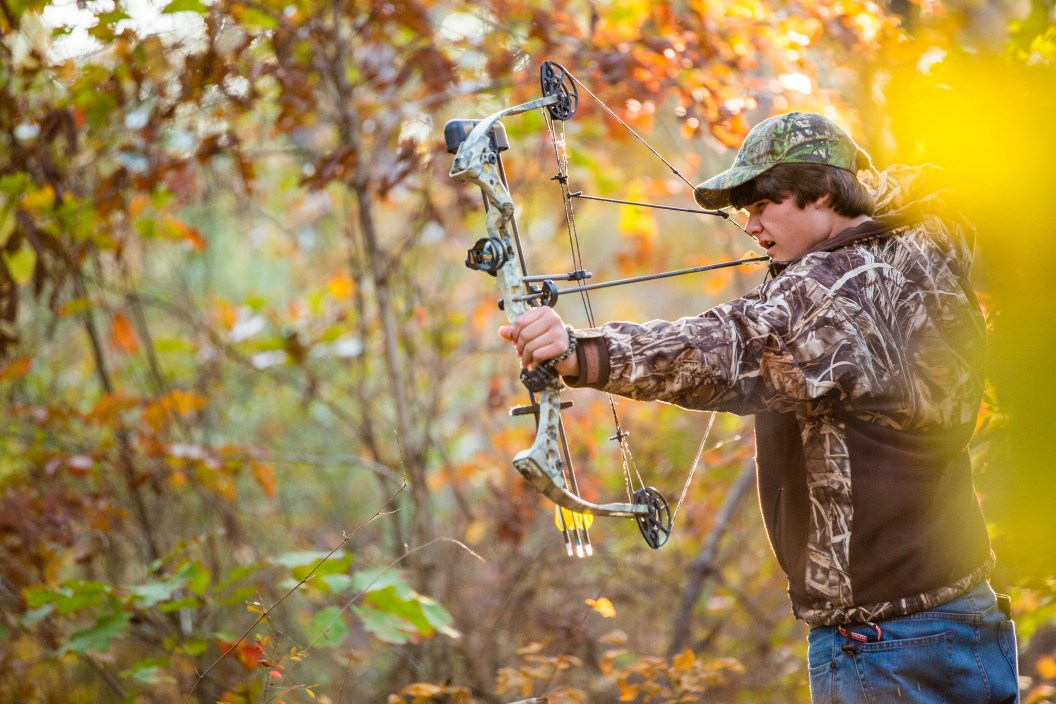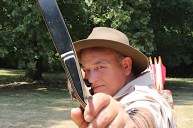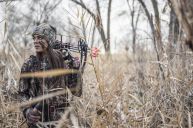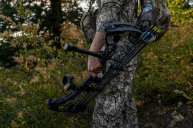As parents, one of the most rewarding things is to share experiences and traditions with your kids, and that often comes alongside teaching them new skills. For many bowhunters, teaching their children to bowhunt is high on the valuable list.
Learning to bowhunt is about so much more than hunting wild turkey or deer: "Hunting is really about camaraderie," says Marilyn Bentz, executive director of the National Bowhunter Education Foundation. Whether alongside a league or your family, hunting allows you to spend quality time with other people.
Kids also learn about the circle of life during deer-hunting season. "The animal [hunted] has a purpose," Bentz says. "Whether it's feeding their family or a family in the community."
The biggest question most parents have: when and how to teach their kids to bowhunt. I ran into this myself a couple of years ago when my son became interested in bowhunting. It's hard to say 'no' if your child shows interest in something new, but how can you tell if they are physically or mentally ready to handle a weapon with competence and respect? And if they are, what's the best way to teach them?
We reached out to a couple of bowhunting experts for advice to impart to parents of kids interested in bowhunting.
At What Age Can Kids Learn to Bowhunt?
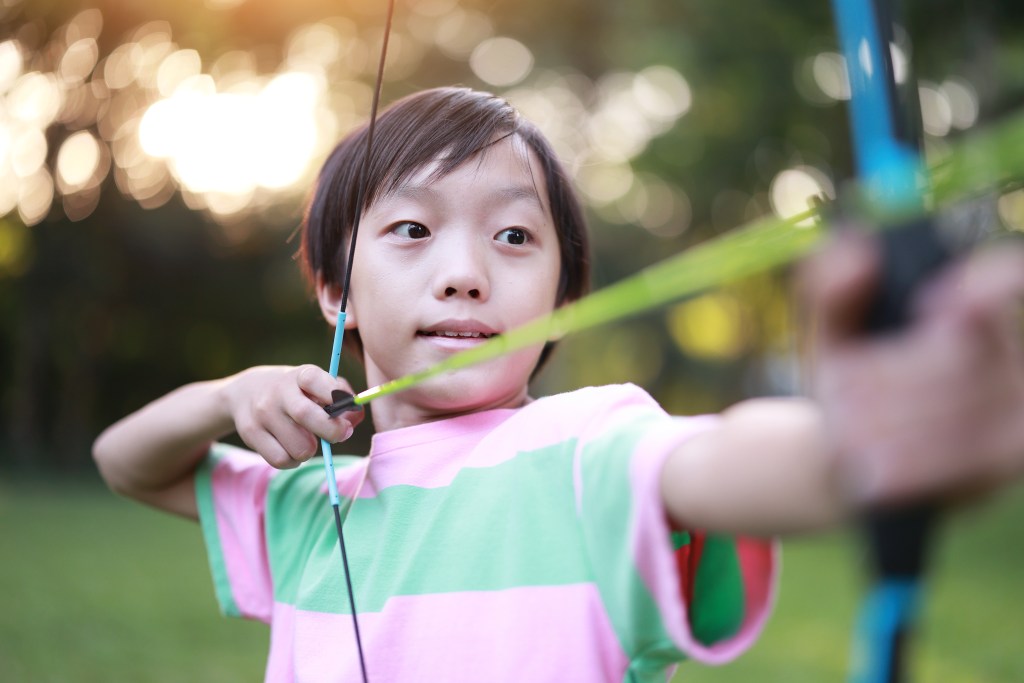
Getty Images, real444
Before you run out and buy your kid their first bow and arrow, you must gauge whether they're ready. I offered my son his first bow when he was 7—and we learned pretty quickly that he wasn't ready. He lacked the strength and the attention span to learn the fundamentals. So I stored the bow and arrows until later—which, it turns out, wasn't until this year at age 9.
However, readiness is relative, and every child is different. Bentz says there are a lot of factors that go into gauging readiness. "If kids have grown up in a bowhunting family, they may be able to start at a younger age," Bentz says, noting that can be as young as 5.
"A lot of kids get started with crossbows, and I've seen kids as young as 6 or 7 years old shooting deer with crossbows," says Sarah Bowmar, a bowhunting expert based in Delaware and the owner and founder of Bowmar Archery. "If your child is proficient with his or her equipment and is strong enough to use the crossbow, your child is ready to bowhunt."
But it's not just all about physical ability or your kid's age. "It's also about maturity and interest," says Brady Kirkpatrick, a lifelong bowhunter and bow tester. "A child who shows respect for weapons, understands safety rules, and displays patience and concentration might be ready. I always say, watch how they handle responsibilities and react to instruction—these are key indicators of readiness."
Kids also need the emotional maturity to understand and process that they are taking a life, but one that holds a purpose. Bentz says that children typically understand the gravity that comes with shooting an animal around age 8. Around the same age, they can also help with field-dressing activities, taking part in cleaning, harvesting, and preparing. Bentz emphasizes that the more you involve kids, the more interested they will become.
How to Choose Their First Bow
Choosing a bow—whether it's a compound bow, recurve, longbow, or crossbow—is a personal experience. The bow needs to fit your child's wingspan and strength level. "It's not like buying a shoe where you can buy it a little bit bigger and grow into it," says Bentz, adding that they need to be able to handle their equipment from the outset.
When you begin shopping for kids' bows, you should narrow it down before you let your child's excitement influence the moment. Show them only a couple of bows that have the appropriate draw weight for their height and strength. Kirkpatrick suggests that parents lean toward bows with adjustable draw length and weight, so the bow will grow with the kids and their abilities.
"Specialty archery shops are ideal as they offer expert advice and a wide range of options," Kirkpatrick says. "Testing multiple bows is crucial. Each bow feels different, and it's important for a child to feel comfortable and confident with their equipment."
While you're at the pro shop, pick up a couple of targets, too. You can easily set up a target in the backyard so your child can practice hitting the bullseye. (After checking your local rules and regulations, of course.)
How to Teach Kids How to Bowhunt
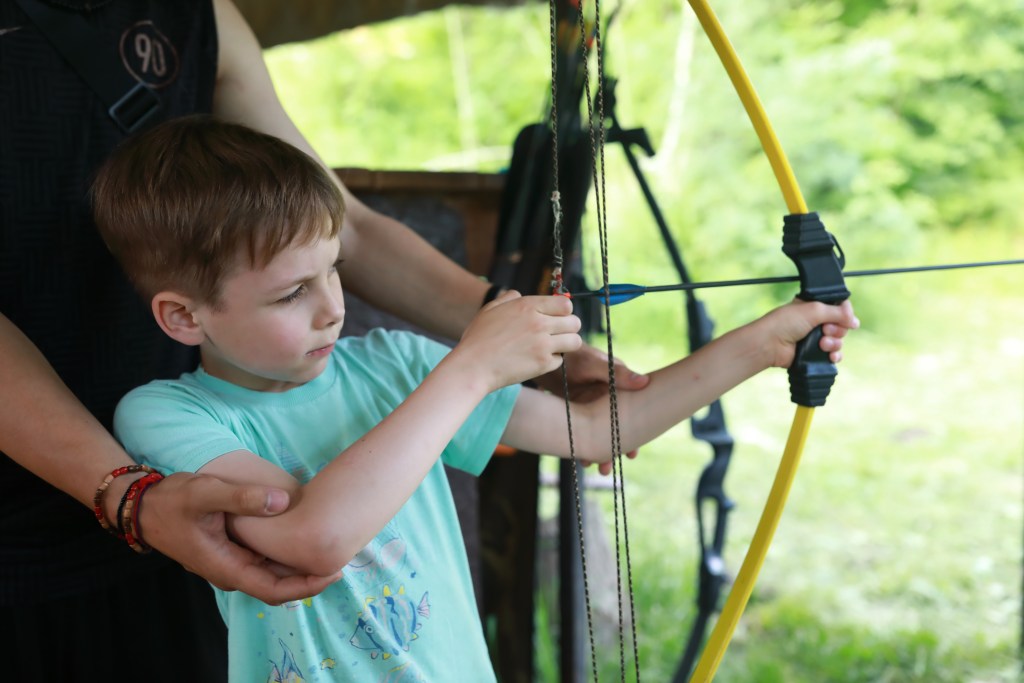
Getty Images, Radist
Teaching your child a new skill can be one of the most simultaneously rewarding and frustrating things a parent can do. These tips can help your one-on-one lessons with your child go smoothly.
1. Learn About the Bow
Give your child the basic rundown, teaching them about their specific bow, arrows, and accessories that they may end up using. At this point, you can teach them how to adjust the poundage as needed, along with how to nock their arrows. Some concepts may be advanced for your new bowhunter, but it will help them learn over time.
2. Determine a Dominant Eye
As humans with binocular vision, one eye is always dominant over the other. Most adults know which one of theirs is, but kids won't. To find your child's dominant eye, have them form a triangle shape with their index fingers and thumbs. With both eyes open, locate an object on a wall or outdoors and center it in the triangle. Have them close only the left eye (or use your hand to cover it). If the object stays centered, the child is right-eye dominant. If it shifts, they are left-eye dominant, which you can double-check by having them repeat the exercise of centering the object with both eyes open, then closing or covering the right eye.
3. Practice Proper Form Using a Target
Place your target in an open area and position your child between 5 and 10 yards away from it, standing so the front foot is pointing toward the target. Typically, this positions the dominant hand toward the back, as that's the hand your child will want to use to pull back the string. The toes of the back foot should be at a 90-degree angle from the front one, and the hand holding the bow (typically their non-dominant) should be straight out and pointing toward the target.
Help your child find their anchor point—where they will pull the string back toward themselves at full draw. This is typically at the curve of their jaw, but they will eventually find a spot that feels comfortable for them. Help them line up their shot by choosing a point of focus on the target. Typically, it's the bullseye. Make sure the bow is lined up with the target, with the arrow pointing at what you want to hit. Before loading an arrow, have them practice pulling back the bowstring with their fingers, point, and release. The release can be tricky, as the fingers don't really go anywhere. Instead, they gently let go.
4. Explain Bow Safety—and Explain It Again
Kids can be a little squirrelly, so it's important that they know not to point the arrows at anyone, especially with the bow. It's all too easy to have an accidental misfire. "A beginner archery course is invaluable," Kirkpatrick says. "It teaches proper technique, safety, and respect for the equipment."
In addition, Bowmar recommends that kids take a hunter safety course. Some states offer the National Archery in the Schools Program to help students become more familiar with the sport of archery, with skills that easily translate over to bow hunting.
5. Visit an Archery Range
Practicing at an archery range can be invaluable for learning. Pros are available to ask questions and may be able to help with bow adjustments as needed. The pro shop may also have several types of bows to try out in advance of investing in one or if your child seems to be having a hard time with the one you bought them.
6. Watch Bowhunting YouTube Videos
If you can't make it to the range, your child can always hop on the web and watch YouTube videos. Bowmar says such videos are an excellent way for kids to continue learning skills if they can't hit the range or go hunt as often as they'd like—just be sure to vet them first, in case they contain content that might be negative or scary to children.
7. Take a Walk in the Woods
Before your child is ready to harvest their own deer, Bentz recommends taking them out scouting with you in the woods. Let them tell you what they see and hear. Another step would be to have your child help you set up a blind, discussing things like weather and wind direction.
Bentz says the more you can include a child in the process, the better, with one exception. "Move to the treestand further down the line," she says. Even if using a treestand is your go-to hunting method, it's not beginner-friendly.
8. Go at Their Pace and Have Fun!
Most kids have relatively short attention spans compared to adults. They may not want to spend a whole lot of time on their shooting practice, especially if they're starting at a young age.
For our family, taking an archery course at school reignited our son's passion for his bow and arrow. Now, most days he spends an hour and a half in his course shooting, only to come home and shoot for another hour or so at home. But some days, he'd rather ride his bike. We give him the flexibility to learn and build his skills, all while keeping it at his pace. He's come a long way since we first bought his bow and will continue to build on that foundation.
The most important thing to remember when teaching your child to bowhunt: Kids learn better when they are having fun!
READ MORE: 8 Fun and Exciting Wilderness Skills to Teach to Kids While Camping
